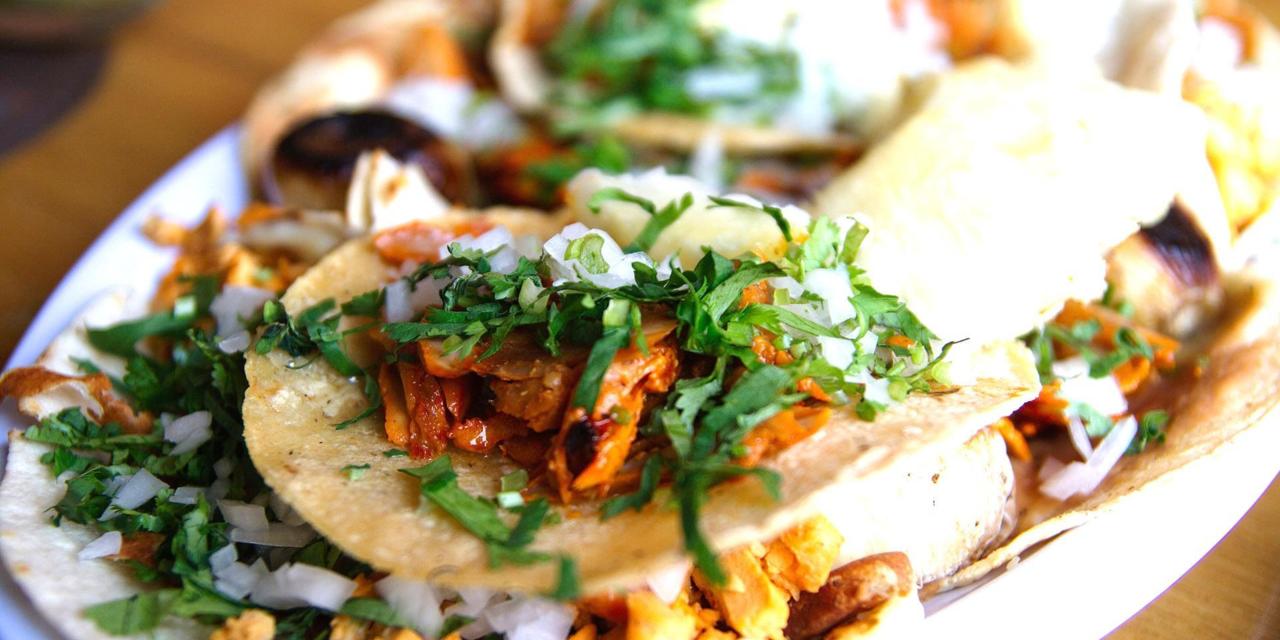This post may contain affiliate links. We may earn money or products from the highlighted keywords or companies or banners mentioned in this post.

I wasn’t exactly at the Mexican version of Benihana, but it felt like it. The taquero, or taco maker, had just shaved off a juicy piece of pork from the trombo, or turning spit, and dropped it onto a corn tortilla. He then reached his knife up to the pineapple pinned to the top of the trombo, and with a quick flick of his wrist, sliced off of a chunk, causing pineapple to fly high over his head. He caught it in the pork-filled corn tortilla behind his back.
“Bravo,” someone yelled, and a gaggle of hungry onlookers burst out into applause.
Welcome to El Vilsito, a Mexico City spot that is special – not necessarily because of the hand-eye coordination of its taco makers – but because it might be the only place on the planet that is an auto mechanic shop during the day and a taqueria at night. It also serves up some of the best al pastor tacos in this city of more than nine million people.
How is al pastor different from carnitas, chorizo, pollo, pescado and other common taco toppings? For starters, by the way it’s cooked: the pork is first marinated with various spices (including achiote, which is native to Mexico) and then roasted by an open flame via the trombo. Next, the pork is carved off, placed inside a corn tortilla and topped with cilantro, onion and pineapple – much like lamb is shaved from a spit and served in some pita bread at a shwarma place.
After that, the taco eater adds sauces – usually red or green – folds the tortilla and commences the juicy pork-liciousness that is the al pastor taco.
According to Jason Fritz, a writer who gives food-themed tours of Mexico City through Club Tengo Hambre, it’s rare to be at El Vilsito sober, or before midnight. It’s just that kind of place you point your taxi driver to if you’re liquored up and remotely close to its Narvarte neighbourhood locale. We broke both of those rules: it was only 8pm and we’d only had one drink.
I asked why al pastor tacos are better than others. “It’s hard to say, but it’s the little things, such as how much soul does a place put into its product,” Fritz said. “Also, every al pastor taqueria has their own marinade – I’ve heard of places using things like orange juice and Coca Cola – and they keep it a big secret.” We asked one of El Vilsito’s taqueros for the recipe, but he only moved his head slowly from side to side: “Oh, just lots of spices.”
Fritz gave me an I-told-you-so look, as our steaming tacos landed in front of us. We added salsa and lime, and commenced eating. The meat was luscious with a nice grizzled crispiness around the edges. The cilantro, onion, pineapple and a squirt of citrus juice gave the tacos several dimensions of flavour, and the chewy corn tortilla offered some texture to the palate. We also tried something called a gringa, which consisted of al pastor pork smothered in cheese on a flour tortilla. The problem with the gringa, at least here, was that the cheese actually took away from the satisfying porky flavour.
“The al pastor taco shows Mexican culture’s power to take something from elsewhere and incorporate it as its own,” said Fritz.
To get at the origins of al pastor, we have to go 12,400km to the east. Specifically, Beirut. After the fall of the Ottoman Empire and in the wake of World War I, many people fled the region fearing political and economic instability. Many Lebanese and other people from the Middle East went to Mexico. They arrived first in the Yucatan, gravitating to Puebla and eventually Mexico City, bringing with them their recipes for spit-roasted lamb. Eventually, the “taco Arabe”, or Arab taco, sprang up; and not long after that, lamb was switched out for pork, pitas for tortillas and the al pastor was born. The name “pastor”, or “shepherd”, is a reference to the original use of lamb.
“I find myself in these debates about what is authentically Mexican,” Fritz said. “For example, what is considered ‘real’ Mexican was food brought by the Spaniards hundreds of years ago.”
Mexican food, similarly to many world cuisines, was not created in a vacuum. World events, colonialism, the end of empires and mass immigration force a cuisine to evolve. Italian cuisine was devoid of tomatoes until they were brought back from the New World in the middle of the 16th Century. The banh mi sandwich in Vietnam would not have been created without French colonialism. Things like war and imperialism are not necessarily a good thing, but sometimes food is a collateral result of them.
The next evening, I turned up at El Fogoncito, a legendary restaurant deeply associated with al pastor. Specifically, the restaurants owners claim to have created the very first gringa taco. I met up with Carlos Roberts, the owner of the restaurant (and son of the original owner), who explained the origins of this gouda-topped al pastor. In 1969, three American women wandered into the restaurant to eat a taco. They liked it, but they wanted flour tortillas instead of corn and asked if they could please have some cheese on it, too. The restaurant complied. “And soon enough”, Roberts said, “people started showing up and saying, ‘We want what those gringas ate.’ And so we eventually just put it on the menu as the ‘gringa taco’.”
The gringa here was satisfying, but like at El Vilsito, the cheese muddied the balanced flavour strata. The regular al pastor, however, was excellent: the pork was sliced extra thin, slightly charred on the edges and had a garlicky undertone.
My favourite taco in New York City, where I live, is the al pastor at Los Tacos No 1 in Chelsea Market. But the al pastor I’d had so far in Mexico City made the Big Apple version seem forever mediocre. What, I wondered, was secret to al pastor’s goodness?
I found my answer a little while later when I accompanied my friend Sucheta Rawal to the upscale restaurant Dulce Patria. Rawal was in town for her non-profit travel company Go Eat Give and needed to chat with celebrity chef Martha Ortiz about the program. I couldn’t help but ask the chef about al pastor. “What makes tacos al pastor so good”, Ortiz said, “is the balance of flavours. You’ve got the citrus and sweet from pineapple, savoury and saltiness from the pork, spiciness from the salsa. It’s really the perfect recipe.”
Perfect, indeed. For my last al pastor in Mexico City, I went to El Huequito with Jason Fritz. “This is like holy ground for tacos,” Fritz said as we approached what amounted to be an open window of a store front in the El Centro section of Mexico City. Since 1960, El Huequito has been slicing pork off a spit and delicately placing it atop corn tortillas. That’s more than 50 years to get the al pastor to near perfection – and you can tell. The tacos arrived rolled up, like tiny burritos and filled with the usual ingredients: cilantro, onion, thinly sliced pork and a piece of pineapple.
They were excellent. The flavour of the pork was bolder than others I’d tried. The outer gristle on the meat had a strong taste of fire and smokiness. These were so good I ordered two more and devoured them quickly. Perfectly balanced in flavour and with the meat done just right, the tacos were the best I’d had in Mexico City.
Full, I wished for a second stomach to be able to eat more. I said goodbye to Fritz and walked off into the bustling centre of Mexico City, passing by signs for “tacos ricos” (delicious tacos). Instead of getting on the subway, I walked back to my hotel in hopes of building up enough of a hunger that I could sneak in one more before heading home.










